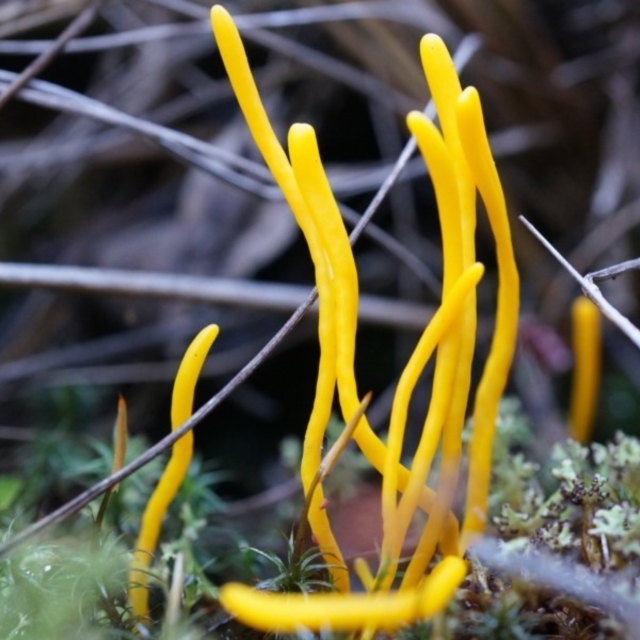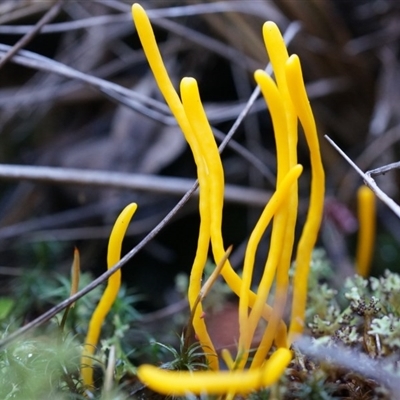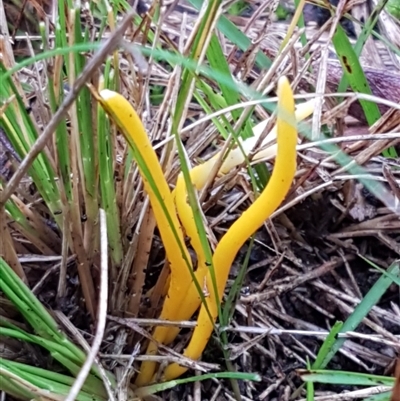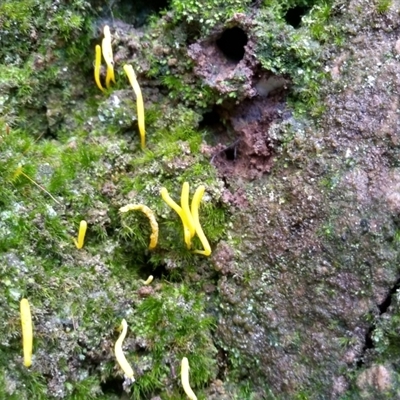Clavulinopsis amoena (Yellow club)
<p> </p>
<p style="margin: 0cm 0cm 0pt; line-height: normal;"><span style="font-family: 'Georgia',serif;"><span style="color: #000000; font-size: medium;">The fruit body is generally a simple, untwisted, club-like growth (generally circular in cross-section but sometimes flattened) but sometimes the tip may be forked. It is yellow to orange and may grow to 10 centimetres tall and up to 5 millimetres in diameter. </span></span></p>
<p> </p>
<p style="margin: 0cm 0cm 0pt; line-height: normal;"><span style="font-family: 'Georgia',serif;"><span style="color: #000000; font-size: medium;">The fruit bodies appear on soil, usually in groups (but not in tight clusters), in native woodlands or forests.</span></span></p>
<p> </p>
<p style="margin: 0cm 0cm 0pt; line-height: normal;"><strong style="mso-bidi-font-weight: normal;"><span style="font-family: 'Georgia',serif;"><span style="color: #000000; font-size: medium;">Look-alikes</span></span></strong></p>
<p> </p>
<p style="margin: 0cm 0cm 0pt; line-height: normal;"><span style="font-family: 'Georgia',serif;"><span style="font-size: medium;"><span style="color: #000000;">The fruit bodies of <em style="mso-bidi-font-style: normal;">Ramariopsis depokensis</em></span></span><span style="color: #000000; font-size: medium;"> (synonym: </span><em style="mso-bidi-font-style: normal;"><span style="color: #000000; font-size: medium;">Clavulinopsis depokensis</span></em><span style="color: #000000; font-size: medium;">) and </span><em style="mso-bidi-font-style: normal;"><span style="color: #000000; font-size: medium;">Ramariopsis fusiformis</span></em><span style="color: #000000; font-size: medium;"> (synonym: </span><em style="mso-bidi-font-style: normal;"><span style="color: #000000; font-size: medium;">Clavulinopsis fusiformis</span></em><span style="color: #000000; font-size: medium;">) are also club-like, yellow to orange and found on soil. Those of the former are commonly twisted (and flattened in cross-section) and those of the latter appear in tight clusters and develop brownish tips. </span></span></p>
<p> </p>
<p style="margin: 0cm 0cm 0pt; line-height: normal;"><span style="font-size: medium;"><span style="color: #000000;"><em style="mso-bidi-font-style: normal;"><span style="font-family: 'Georgia',serif;">Calocera</span></em><span style="font-family: 'Georgia',serif;"> fruit bodies are often simple, yellow to orange stalks but they grow on wood.</span></span></span></p>
<p> </p>
<p style="margin: 0cm 0cm 0pt; line-height: normal;"><strong style="mso-bidi-font-weight: normal;"><span style="font-family: 'Georgia',serif;"><span style="color: #000000; font-size: medium;">Reference</span></span></strong></p>
<p> </p>
<p style="margin: 0cm 0cm 0pt; line-height: normal;"><span style="font-family: 'Georgia',serif;"><span style="font-size: medium;"><span style="color: #000000;">P. & E. Grey. (2017). <em style="mso-bidi-font-style: normal;">A little book of corals</em></span></span><span style="color: #000000; font-size: medium;">, Revision 2. Available at: http://www.fncv.org.au/wp-content/themes/field-naturalist/publications/a_little_book_of_corals.pdf. See the illustrated entries for </span><em style="mso-bidi-font-style: normal;"><span style="color: #000000; font-size: medium;">Clavulinopsis amoena</span></em><span style="color: #000000; font-size: medium;">, </span><em style="mso-bidi-font-style: normal;"><span style="color: #000000; font-size: medium;">Clavulinopsis depokensis</span></em></span><span style="color: #000000; font-family: Arial; font-size: medium;"> and </span><em style="mso-bidi-font-style: normal;"><span style="font-family: 'Georgia',serif;"><span style="color: #000000; font-size: medium;">Clavulinopsis</span></span></em><span style="font-family: 'Georgia',serif;"><span style="font-size: medium;"><span style="color: #000000;"> <em style="mso-bidi-font-style: normal;">fusiformis</em></span></span><span style="color: #000000; font-size: medium;">.</span></span></p>
<p> </p>
Clavulinopsis amoena is listed in the following regions:
Canberra & Southern Tablelands | South Coast
Species information
- Clavulinopsis amoena Scientific name
- Yellow club Common name
- Not Sensitive
- Local native
- Non-invasive or negligible
- Up to 978m Recorded at altitude
- Machine learning























